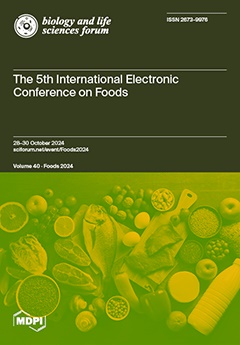Ver ítem
- xmlui.general.dspace_homeCentros Regionales y EEAsCentro Regional Tucumán - Santiago del EsteroEEA Santiago del EsteroArtículos científicosxmlui.ArtifactBrowser.ItemViewer.trail
- Inicio
- Centros Regionales y EEAs
- Centro Regional Tucumán - Santiago del Estero
- EEA Santiago del Estero
- Artículos científicos
- Ver ítem
Influence of the Application of Rosemary Essential Oil (Salvia rosmarinus) on the Sensory Characteristics and Microbiological Quality of Minimally Processed Pumpkin (Cucurbita moschata)
Resumen
Pumpkin (P) production in Santiago del Estero, Argentina, is of high quality. The product is sold whole and fresh, and is traditionally consumed after being cooked in water. Due to its pleasant flavor (semi-sweet), it is widely accepted among consumers, being a potentially versatile product to be consumed fresh or minimally processed (MP). Processing increases food’s susceptibility to microbial spoilage, making it necessary to use sanitizers. In this
[ver mas...]
Pumpkin (P) production in Santiago del Estero, Argentina, is of high quality. The product is sold whole and fresh, and is traditionally consumed after being cooked in water. Due to its pleasant flavor (semi-sweet), it is widely accepted among consumers, being a potentially versatile product to be consumed fresh or minimally processed (MP). Processing increases food’s susceptibility to microbial spoilage, making it necessary to use sanitizers. In this work, the effect of different application methodologies at different concentrations of rosemary essential oil (REO) on the sensory characteristics and microbiological quality of grated P was evaluated. The product was washed, sanitized, cut, peeled, grated and centrifuged, and then REO was superficially incorporated in two concentrations (4 and 8 μL/mL), applied in three ways: sprayed (TA), immersion (TI) and by strips embedded in EO being adhered to the storage container (TV). The product was subsequently stored at 5 °C in sealed polypropylene bags of 35 μm. In addition, an immersion treatment with NaClO-100 ppm-3 min and a control without any additive were included. Samples were taken at 24 h and 8 days of storage, evaluating mesophilic aerobic microorganisms (MA), psychrophilic (Psy), enterobacteria (E) and mold and yeasts (MY). Sensory evaluation was carried out by trained judges, determining that aroma and flavor were the critical attributes for acceptability. At the end of storage, microbiological analysis showed that REO treatments presented levels of 107 CFU/g, similar to NaCLO treatment, except TI with both concentrations, which was more effective in inhibiting the development of Psy and MY. Regarding aroma evaluation, at 8 days all treatments were acceptable, with the exception of TI and TV (8 μL/mL), while for flavor all treatments were acceptable with the exception of TI for both concentrations. Therefore, the application of TA and TV treatments at the lowest concentration could be considered for further studies to increase the shelf life of MP P.
[Cerrar]

Autor
Benites, Julio Federico;
Gutiérrez, Diego Ricardo;
Ruiz, Silvana Cecilia;
Rodriguez, Silvia del Carmen;
Descripción
Artículo presentado al 5th International Electronic Conference on Foods, 28–30 October 2024
Fuente
Biology and Life Sciences Forum 40 (1) : 37. (February 2025)
Fecha
2025-02
Editorial
MDPI
ISSN
2673-9976
Formato
pdf
Tipo de documento
artículo
Palabras Claves
Derechos de acceso
Abierto
 Excepto donde se diga explicitamente, este item se publica bajo la siguiente descripción: Creative Commons Attribution-NonCommercial-ShareAlike 2.5 Unported (CC BY-NC-SA 2.5)
Excepto donde se diga explicitamente, este item se publica bajo la siguiente descripción: Creative Commons Attribution-NonCommercial-ShareAlike 2.5 Unported (CC BY-NC-SA 2.5)


